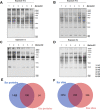The crotonylated and succinylated proteins of jujube involved in phytoplasma-stress responses
- PMID: 38750524
- PMCID: PMC11094900
- DOI: 10.1186/s12915-024-01917-x
The crotonylated and succinylated proteins of jujube involved in phytoplasma-stress responses
Abstract
Background: Protein posttranslational modifications (PTMs) are fast and early responses to environmental changes, including pathogen infection. Jujube witches' broom (JWB) is a phytoplasma disease causing great economic loss in jujube production. After phytoplasma infection, the transcriptional, translational, and metabolic levels in jujube were activated, enabling it to survive during phytoplasma invasion. However, no study has yet reported on PTMs in jujube. Lysine crotonylation (Kcr) and lysine succinylation (Ksu) have been popular studies in recent years and their function in plant phytoplasma-stress responses remains unclear.
Results: Here, 1656 crotonylated and 282 succinylated jujube proteins were first identified under phytoplasma-stress, of which 198 were simultaneously crotonylated and succinylated. Comparative analysis revealed that 656 proteins, 137 crotonylated and 43 succinylated proteins in jujube were regulated by phytoplasma infection, suggesting that Kcr was more universal than Ksu. Kcr differentially expressed proteins (DEPs) were related to ribosomes, photosynthetic and carbon metabolism, while Ksu DEPs were mainly involved in carbon metabolism, the TCA cycle and secondary metabolite biosynthesis. The crosstalk network among proteome, crotonylome and succinylome showed that DEPs related to ribosomal, peroxidases and glutathione redox were enriched. Among them, ZjPOD51 and ZjPHGPX2 significantly increased at the protein and Kcr level under phytoplasma-stress. Notably, 7 Kcr sites were identified in ZjPHGPX2, a unique antioxidant enzyme. After inhibitor nicotinamide (NAM) treatment, GPX enzyme activity in jujube seedlings was reduced. Further, site-directed mutagenesis of key Kcr modification sites K130 and/or K135 in ZjPHGPX2 significantly reduced its activity.
Conclusions: This study firstly provided large-scale datasets of Kcr and Ksu in phytoplasma-infected jujube and revealed that Kcr modification in ZjPHGPX2 positively regulates its activity.
Keywords: Crotonylome; Enzyme activity; Inhibitor NAM; Jujube phloem; Phytoplasma-stress; Site-directed mutagenesis; Succinylome; ZjPHGPX2.
© 2024. The Author(s).
Conflict of interest statement
The authors have no conflict of interest to declare.
Figures







Similar articles
-
Transcriptome profiling analysis revealed co-regulation of multiple pathways in jujube during infection by 'Candidatus Phytoplasma ziziphi'.Gene. 2018 Jul 30;665:82-95. doi: 10.1016/j.gene.2018.04.070. Epub 2018 Apr 27. Gene. 2018. PMID: 29709641
-
Phytoplasma-induced Changes in the Acetylome and Succinylome of Paulownia tomentosa Provide Evidence for Involvement of Acetylated Proteins in Witches' Broom Disease.Mol Cell Proteomics. 2019 Jun;18(6):1210-1226. doi: 10.1074/mcp.RA118.001104. Epub 2019 Apr 1. Mol Cell Proteomics. 2019. PMID: 30936209 Free PMC article.
-
Influences of Jujube Witches' Broom (JWB) Phytoplasma Infection and Oxytetracycline Hydrochloride Treatment on the Gene Expression Profiling in Jujube.Int J Mol Sci. 2023 Jun 18;24(12):10313. doi: 10.3390/ijms241210313. Int J Mol Sci. 2023. PMID: 37373459 Free PMC article.
-
Cracking Lysine Crotonylation (Kcr): Enlightening a Promising Post-Translational Modification.Chembiochem. 2025 Jan 14;26(2):e202400639. doi: 10.1002/cbic.202400639. Epub 2024 Oct 27. Chembiochem. 2025. PMID: 39462860 Free PMC article. Review.
-
Emerging roles of non-histone protein crotonylation in biomedicine.Cell Biosci. 2021 May 31;11(1):101. doi: 10.1186/s13578-021-00616-2. Cell Biosci. 2021. PMID: 34059135 Free PMC article. Review.
Cited by
-
The ZjMYB44-ZjPOD51 module enhances jujube defense response against phytoplasma by upregulating lignin biosynthesis.Hortic Res. 2025 Mar 19;12(7):uhaf083. doi: 10.1093/hr/uhaf083. eCollection 2025 Jul. Hortic Res. 2025. PMID: 40343351 Free PMC article.
References
MeSH terms
LinkOut - more resources
Full Text Sources
Miscellaneous

